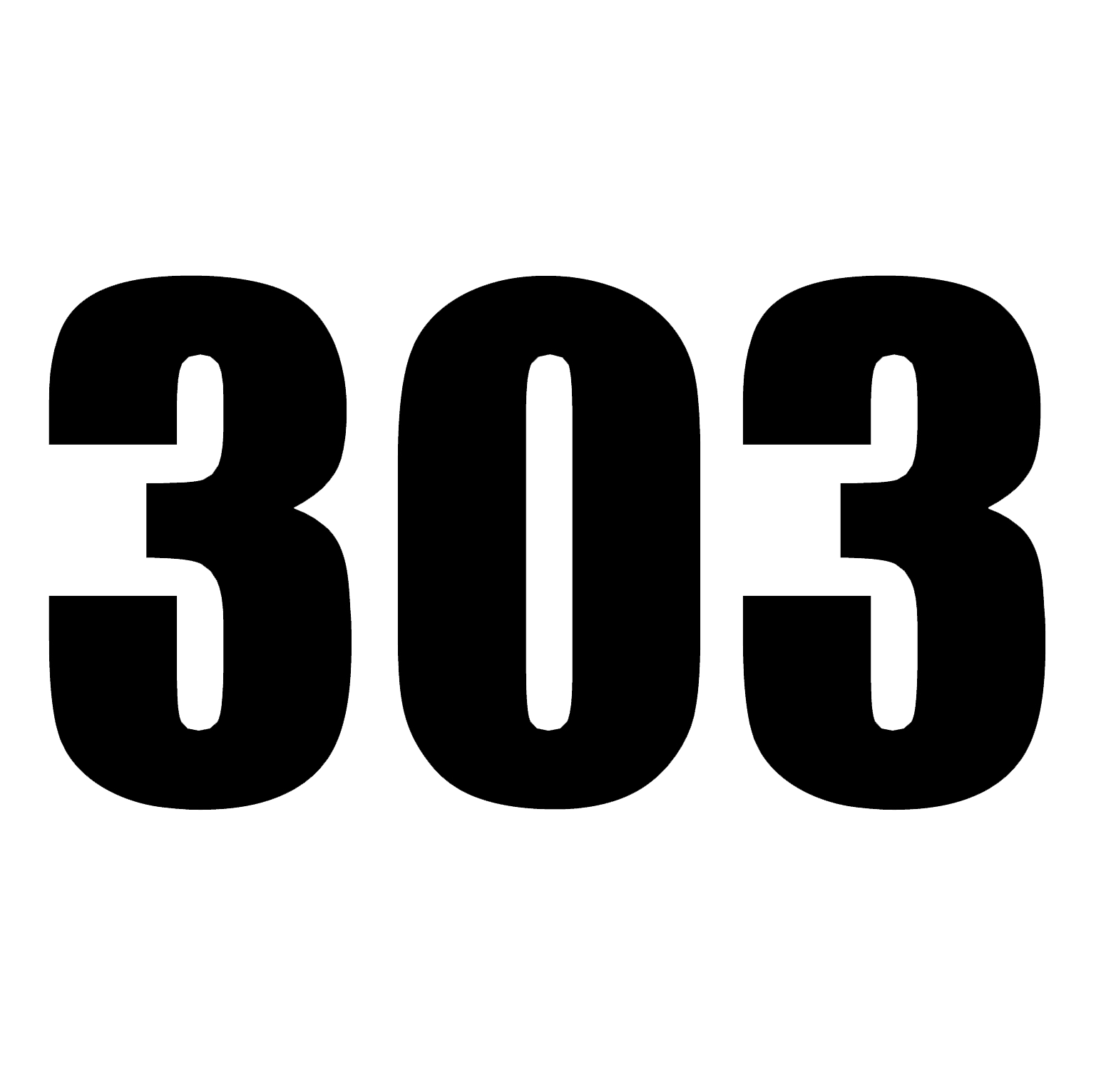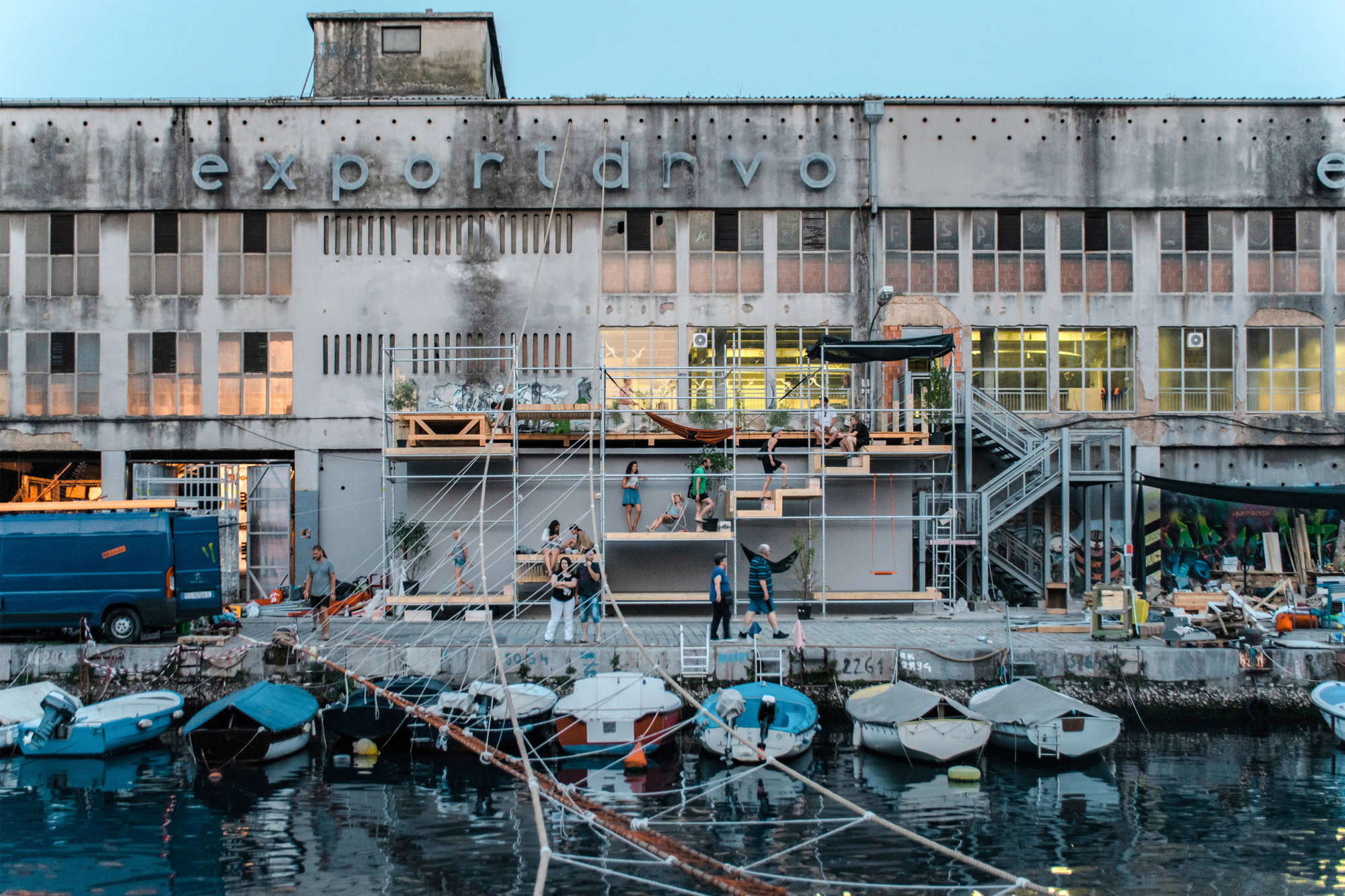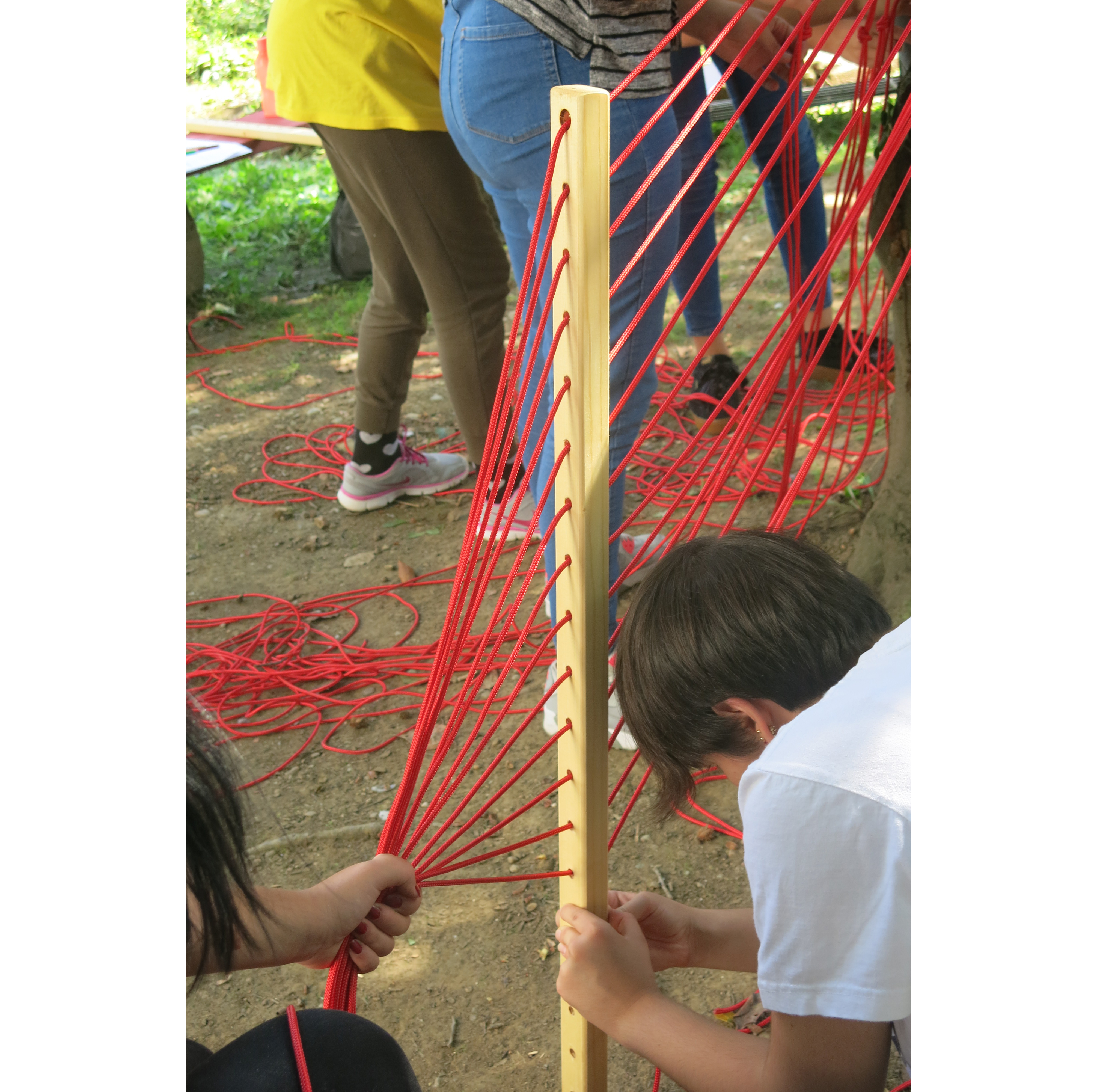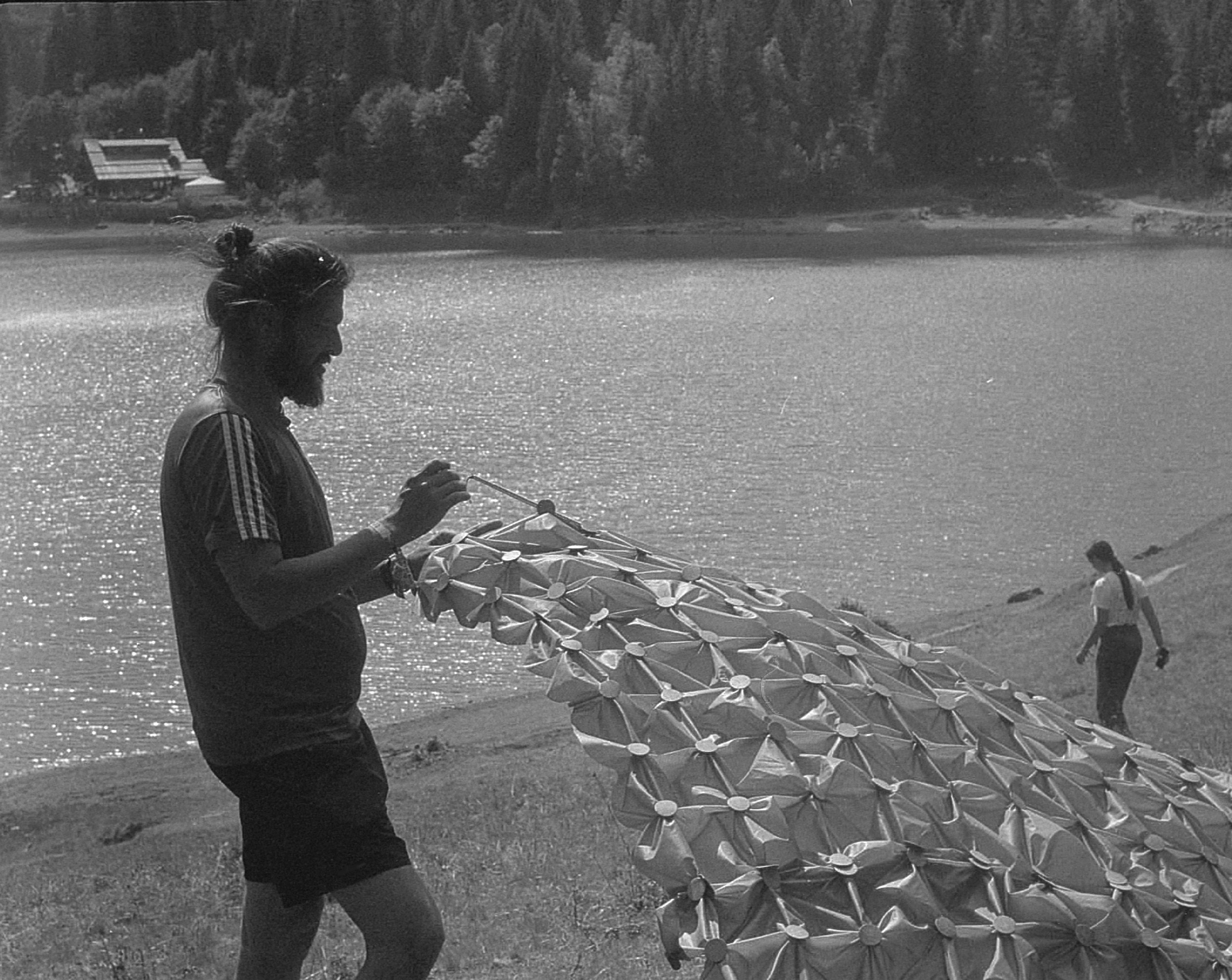“Our pavilion was site-specific but at its core it helps to tackle an issue that is universal. ”
– Brett Mahon
The industrial heritage of Rijeka today is widely neglected and underused. For some, this was a huge inspiration. Young architects Brett Mahon, Joonas Parviainen, Saagar Tulshan, Shreyansh Sett and Vanja Borović took on the challenge of adding a new piece to an incomplete puzzle of Rijeka’s Delta, and were soon joined by a creative force of 23 young Easians (you can find the “Easian” definition here).
We talked to the Level Up team, hoping to dive deeper into their inspirations and aspirations regarding the pavilion, which has in the meantime gained widespread viral success and acclaim from a number of professional outlets.
To start off, how does Level Up relate to last year’s EASA theme of “Re”? If you’ve worked with similar structures before, what was different this time?
Saagar: Level Up embedded the Re:EASA theme in two ways, the first was to reuse and rejuvenate an abandoned and disused outdoor space; the second was to use recyclable materials that are usually not part of the mainstream. We’ve worked a lot with wood before but this was the first time we used steel scaffolding as the structural frame.
Joonas: Level Up was about rethinking the existing built environment in front of Exportdrvo, how to make the rooftop with such a potential with the 180 degree view over Rijeka accessible and inviting. We knew the structure would be only temporary and wanted to make it possible to reuse everything we used for the pavilion after it is taken down. The scaffolding and the wood can be used for something else later on.
We took the theme seriously and thought a lot about the philosophy behind the pavilion: what should be built there, if anything, and why? The design process for Level Up was really fruitful. Before drawing or modeling anything, we talked for weeks via skype and on facebook chats about the aim of the workshop. When we started modeling the pavilion it took us just two days to design, since we already knew everything we wanted to do.
Brett: As Joonas and Saagar explained, the process was quite thoughtful with a lot of questioning on the need for intervention. From the start we always had the thought of a structure that would allow for adaptive reuse and as the idea developed so did the philosophy of “Re” – in the sense that we wanted to create a structure that would plug into an existing situation and enhance the atmosphere which therefore in turn would demonstrate a solution which does not involve destruction but instead adaptation. As Saagar says we have worked a lot with timber in the past, although this time round the emphasis was put on the speed and ease of constructing in modulars with timber as the structure itself was a lot bigger than previous structures we have worked on.
Vanja: This was my first construction-based workshop, and also my first experience with working with these type of materials, so everything was new and exciting for me. The boys were very skillful with the proper treatments of the wood, they taught me and the participants a lot, and working with scaffolding didn’t pose us any problems. The beauty of these materials is that they are universal, and because of that from the beginning of our design process, we had the vision of reusing and recycling the structure after it’s due date. Although I still hope that one day our design will find its way in the permanent life of the Delta and the city of Rijeka.
[Best_Wordpress_Gallery id=”267″ gal_title=”levelup1″]You had a huge responsibility of overseeing over twenty participants. We have no doubt that this was a valuable experience for them, but what did they teach you as tutors?
Saagar: We were fortunate to have a beautiful team of talented individuals from 22 countries. The participants brought a lot of different perspectives to the table, from exploring different approaches towards material to making our workflows more efficient since we were on a tight schedule. More importantly, the workshop was a melting pot of different cultures, ideas and thoughts. Our most valuable takeaway from Level Up was the family we became as we worked together towards building this pavilion.
Shreyansh: Our process of working as a team was based on the foundation of trust and it was very non-hierarchical in nature. And we were very fortunate to be able to function that way. Whenever you are doing a public project the structure comes second to people, and that’s how even our workshop was structured. We started with an aim to learn from each other and thus we made sure that during our team selection we had people from as many countries as possible to widen our spectrum of learning. Our participants were an amazing group of people who added a lot of character to the team and the structure, thus there was no overseeing required. The experience of tutoring was thus a very cultural experience. There was a lot more happening around the process which was non-architectural. From people dancing to music from different countries to even cooking different food, it truly was a cosmopolitan affair.
Joonas: I believe that even none of us tutors had worked on such a large construction before, but together with the amazing team everything went well and we managed to finish in time for everyone to enjoy Level Up before the event ended. The team spirit we had together was something exceptional for such a large scale construction workshop. Working hard in the exhausting heat was balanced by a lot of fun. Some unforgettable moments include everyone dancing and shouting to Rihanna’s “Umbrella” under an umbrella during one of the sudden showers that swept over Exportdrvo almost daily, or the whole team almost missing our workshop presentation since we instead hanged out on top of Level Up, enjoying the just-finished pavilion together.
[Best_Wordpress_Gallery id=”268″ gal_title=”levelup2″]Would you consider your workshop to be site-specific or acontextual? Was Rijeka crucial to the success of Level Up or could it be implemented as a “typological solution” into any industrial site with similar problems as Exportdrvo?
Saagar: The design of the pavilion was very site-specific but the approach to this design and the framework we created around material use and utility was acontextual, the structure is modular and can be replicated to suit virtually any other context. Exportdrvo and Rijeka gave us the perfect testbed for this typology as because of their post-industrial identity, and the need for retrofitting and adaptively reusing these ex-industrial areas as new public space havens.
Brett: Having grown up in a post-industrial city myself, I feel the problems are quite universal across many cities. As Saagar says, our pavilion was site-specific but at its core it helps to tackle an issue that is universal. I wouldn’t say it’s a solution but more of a catalyst to a solution in dealing with ex-industrial sites which are threatened by pointless demolition.
Shreyansh: Level Up as an idea was very site-specific. The idea originated from the site. Before we knew what we wanted to build, we knew where we wanted to build. Then the entire process was developed around the intention of doing justice to the site. The intention was to attract more people to the Exportdrvo building which was losing its importance. The form itself was dictated by the site. For instance, the robust wooden platforms were created to withstand the high wind speeds in Rijeka and the spacing in the platforms was to ensure the wind passes through easily without the structure being affected. So it is very site-centric but also has room to be ‘topological’ in terms of an idea. That’s one reason we picked the materials we built with. Simple scaffolding and wood. Which is easily available and can be disassembled and reinstalled wherever the need to be mingling around the boundaries of permanence and ephemeralism arises.
Joonas: No design should be just copied as such to another place, since I believe architecture is always site-specific, but the concept – occupying an underused spot and turning it into an inviting public space, reusability of construction materials, using an existing industrial system as primary structure – could easily be applied elsewhere. I think Level Up was not really about fixing a problem, but seeing and realising the hidden potential of the area. Similar spots can be found practically everywhere around us, but most fruitful would be to concentrate on turning underused or unformed spaces into something special. This way the build environment as a whole will improve.
Vanja: The design was inspired by the site and our desire to create new public space for the specific industrial area in Rijeka and its needs. While we were designing the structure, we focused on creating eye-catching design that will engage the community in an array of activities, and create a social space for everyone in the society to participate in. With that being said, the modular system we used can be independently created and then used in different systems for another location with similar needs.
[Best_Wordpress_Gallery id=”271″ gal_title=”levelup3″]We noticed that Level Up was one of the most inclusive workshops. Specifically, you collaborated with Masonry, Rijeak and Nomads. How important is the collaboration between different workshops at EASA? Do you have any advice to offer to future tutors?
Saagar: I think being absolutely open to collaborating with other workshops added to the success of Level Up. We would like to appreciate the willingness to collaborate from other workshops, and how RE:EASA became a catalyst to that initiative. We exchanged ideas, techniques and participants during the course of RE:EASA. We believe that workshops and projects must take advantage of the open EASA framework and not work in silos. Collaboration is a value we base our philosophy on and it helps us, at EASA, reach our maximum potential.
Joonas: For true collaboration it is useful to have well-defined tasks to share with other workshops, or then to allow them to build on top of what you have done. The scale of Level Up allowed it to act as a platform for other workshops. For example, Rijeak saw the potential in the incomplete structure and put up their swing as soon as we got the scaffolding up. With Masonry we designed together the beautiful mosaic steps they made for us.
Brett: Another useful point to add is that continuous dialogue and communication is key to collaboration. At EASA things can move super fast and it is always important to keep an open dialogue and continue to share ideas back and forth, collaboration isn’t just an add-on to someone else’s idea, it is a conversation between multiple parties from start to finish. I think the setting and openness of EASA really allows for this to happen.
Shreyansh: Collaboration is the future of our profession and not just at EASA. Meaningful collaborations always add value to the project. Thus we were very open to understand and work with the other workshops. Doing that helped us resolve even the smallest details which otherwise would not have been possible to address at such a scale. For example, the texture and the sizes of stone on the handcrafted concrete steps.
[Best_Wordpress_Gallery id=”272″ gal_title=”levelup4″]Being that the structure is programmatically neutral and demands interaction, did the EASA community offer any unexpected uses of the platform that you never thought of?
Saagar: That’s a great way to look at public spaces in general, you might design them for a specific use and function but the way the public responds to them will always surprise you. Another way of saying this is that although a public space should satisfy a need or utility, it’s important for them to be flexible and truly a part of the commons. In the time that we were working on Level Up it was used as a film screening pavilion, a viewing platform, a party deck, a sleeping stand, a performance stage, etc. We only look forward to more creative ways people will use this pavilion.
Joonas: I don’t think we expected anyone to take over the rooftop terrace already before we had made the steps, but midway through EASA people started to sleep on top due to the perfect sleeping conditions outside, compared to the heat and humidity inside. During the second week we started working every day with around fifty Easians waking up on Level Up.
Brett: Over the two weeks of Easa I get the feeling that the structure itself had seen all amounts of activities, some of which probably can’t be printed in words. It was great to see it being used from the moment the first piece of decking was layed and I would often think to myself, “how did people manage to get up there” as there was no route up and all had been cornered off in order not to allow access. We soon began to just trust and accept people would be using the structure as we were still working away on it.
Shreyansh: The whole intention of Level Up was to act as an interaction space for people, with Exportdrvo as a backdrop. And while we wanted people to interact, we never wanted to dictate the activity vis-à-vis with the structure. It was supposed to be a platform, a platform which can be transformed into whatever you want it to be. And so it was. People have done everything on that structure. I have seen people watching movies with the hills in the backdrop, reflected on some deep conversation overlooking the sunset at the sea, drinking to the view of the city centre right in front of the structure across the canal and some even made love under the starry sky above the Level Up deck. From sleeping to dancing, people have done it all on that structure. And it was pretty overwhelming to see that. I always feel that it’s the people who add value to a space. The way they love it, respond to it – that’s what makes all the difference and the EASA community and the people of Rijeka have been very kind in reciprocating their love towards Level Up.
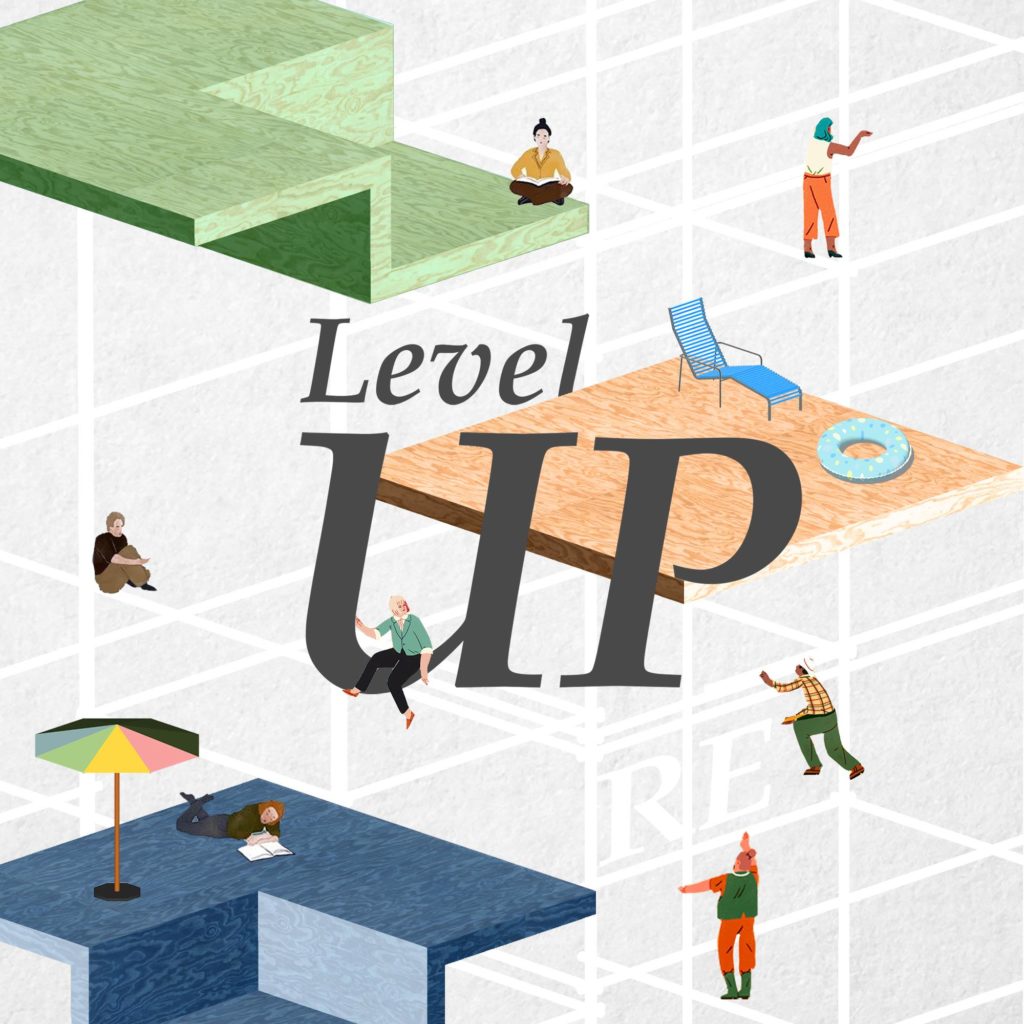
Tutors: Brett Mahon (Northern Ireland), Joonas Parviainen (Finland), Saagar Tulshan (India), Shreyansh Sett (India), Vanja Borović (Croatia)
Participants: Ana Mateos, Anna Opitz, Anton Fedin, Ásta María Thorsteinsdóttir, Ayşe Tuğçe Pınar, Birgit Fløystad, Caro Andrade, Ciaran Magee, Chloë Reyda, Felic Micallef, Gleb Rudenya, Glenn McNamara, Gustavs Grasis, Ilia Bebi, Joanna Lewanska, Julia Triches, Julien Hermant, Klemen Mraz, Mattea Fenech, Samúel Aron Laufdal Guðlaugsson, Sebastian Bidault, Simona Svitkova, Tadhg Spain
Photos: Rahul Palagani
Interview and translation: Igor Vukičević
